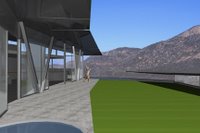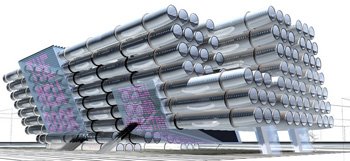 Frank Gehry was on to something: he revolutionized architecture by using aerospace engineering to create wavy panels of structurally sound stainless steel and titanium. But two new projects follow his inspirations in more literal fashion: by incorporating actual airplane parts into the structures.
Frank Gehry was on to something: he revolutionized architecture by using aerospace engineering to create wavy panels of structurally sound stainless steel and titanium. But two new projects follow his inspirations in more literal fashion: by incorporating actual airplane parts into the structures. The 747 Wing House by David Hertz of Syndesis Inc. aims to provide an ecological living arrangement that capitalizes on the feminine curves of a 747 body. Designed for Francie Rehwald, owner of one of California's biggest Mercedes-Benz dealerships, the home in the Malibu hills will reuse airplane parts, including a nose cone that will become a meditation pavillion and wings that'll form a roof supported by rammed-earth walls. While the Syndesis website goes a bit overboard on claims of sustainability ("As we analyzed the cost, it seemed to make more sense to acquire an entire airplane and to use as many of the components as possible, like the Native American Indians used every part of the buffalo."), the project isn't cheap: BBC reports that the pricetag for plane parts won't top $100,000, but total construction, starting in June, is "likely to cost several million dollars."
 Meanwhile, not so far away in Guadalajara, the design and architecture firm LO-TEK has conceived of a library made from fuselages of decommissioned 727s and 737s. As Worldchanging quotes:
Meanwhile, not so far away in Guadalajara, the design and architecture firm LO-TEK has conceived of a library made from fuselages of decommissioned 727s and 737s. As Worldchanging quotes:The fuselage is the only part of a decommissioned airplane that cannot be effectively recycled. The cost of its demolition exceeds the profit of aluminum resale. A huge amount of fuselages lays in the deserts of the western states. Boeing 727 and 737 are historically the most sold commercial planes and therefore the most common in these graveyards. They are sold at very low prices completely stripped and in great structural conditions.For more on the Jalisco Library, visit Noticias Arquitectura.
No comments:
Post a Comment